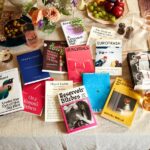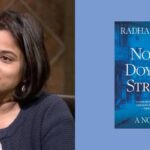Claire Messud: What I Learned From My Mother’s Library
The Author of The Burning Girl on the Women Writers She Grew Up With
Each of us is made up of our lived experiences, of course; but also, both consciously and unconsciously, of all the stories that we have heard, read or watched. Without realizing it, we come to understand what a story is and how it means by the accretion of narratives in our heads.
We know without being told that an hour spent watching the Kardashians is quite different from an hour spent reading Kant; by extension, an hour spent reading Harry Potter is different from an hour reading the works of Primo Levi. I say this with no disrespect to Harry Potter, an enormously compelling and influential series of books enjoyed by millions; but simply to point out that one set of books is a fantasy about the struggle between “good” and “evil”; whereas the second is, well, for real, not because it’s non-fiction but because it is the complex, contradictory, scrupulous and self-knowing account of one man’s experiences during the very real Second World War. (In this internet age, in which fantasy seems bafflingly to have attained the status of a new reality, let it be reiterated: actual reality is intractably, awfully, and profoundly real; and actual facts are the record of that intractable reality. Not to grasp this is to succumb to a potentially fatal ethical corruption of the soul.)
As kids, we devour the stories that fall beneath our hands (or eyes). As a child in Australia and Canada, I read Enid Blyton, Eleanor Farjeon, Ivan Southall and Farley Mowat along with Judy Blume, E.L. Konigsburg and Ursula LeGuin. The narratives each of us happens upon are of course culturally specific, and change over time; although some seminal stories persist. What my kids, now teenagers, have read at school is more contemporary and diverse in authorship than what my schools offered when I was young, which is an excellent thing; but in middle and high school they still read The Iliad, The Odyssey and Shakespeare, which is just as important. What they read for pleasure is also quite different to what I read: 35 years ago, YA didn’t exist as a genre (with the exception of S.E. Hinton’s The Outsiders), and so, from the age of 12 or 13, I plundered my parents’ bookshelves for reading material.
More specifically, I turned to my mother’s library. Both my parents were avid readers, the sort of people whose ideal weekend outing was a long drive to an excellent second-hand bookstore, where they’d spend an hour or two browsing in church-like silence and emerge each bearing a stack of unexpected discoveries. Plus, wherever we lived, my mother may have been the most devoted patron of our local library, supplementing her reading material with stacks of plastic-covered hardbacks, of which she kept a meticulous list in a notebook in her handbag so as not to run up fines.
My father read almost exclusively non-fiction: history, biography, philosophy, cultural criticism. He had a particular interest in the history of Christianity in the Middle East, and collected a vast number of books about Mediterranean history and Byzantium; but he could also surprise us. I remember going to summon him to supper and finding him in his leather chair, in his half-moon glasses, deeply ensconced in Greil Marcus’s Lipstick Traces. My mother, on the other hand, read chiefly novels and literary biographies, and as I was myself from the first a lover of fiction, it was in her footsteps that I eagerly, unthinkingly followed.
As a child, you take your experiences for granted and imagine that they’re normal. For many years I thought that every family subscribed to more magazines than they could possibly read (the prized New Yorker in the loo, my mother’s only truly private space; The New York Review in piles upon the sideboard; The Atlantic and Harpers on the floor by the living room sofa, usually open to the middle of a long article, left unfinished), and stacked their books in double rows on the shelves so as to fit more in, before starting to pile them behind armchairs and under beds.
By the same token, for a long time I believed that the books I read were more or less universally known. It didn’t occur to me that by borrowing and devouring books selected by my mother, I was being shaped by her predilections, thoughts and desires. If I hadn’t loved what I read, I might have balked and explored a different canon—which, in time, I did of course. By my late teens, I’d become a devotee of Faulkner and Dostoevsky—“why such sinister books?” my mother would ask with a sigh. “So depressing! Isn’t life difficult enough?”—but that was later. What I took in at my mother’s knee—the first adult novels and stories that I read—formed my literary tastes and gave me a particular sense of what made a novel enticing. Only later would I discover that apparently fewer people were attracted by these books than were keen to read Faulkner or Dostoevsky, let alone Hemingway or Fitzgerald: it was as if my mother had shown me the pleasures of the 11th arrondissement without first taking me to see the Louvre or the Eiffel Tower.
I don’t know why I read Mary Wollstonecraft’s Vindication of the Rights of Women in seventh grade, other than that my mother had a copy in the guest bathroom. It can’t properly count as a formative book for me, because at the age of eleven I didn’t really understand it (even the syntax was difficult). But I knew from conversations with my mother that it was important. I do remember reading Antonia White’s Frost in May at about the same time, a wonderful novel published in 1978 by Virago as one of its first reissued classics. (Thank God for Carmen Callil and her amazing publishing enterprise!) Many my age and older will recall the novel’s army-green glossy spine, its cover image of a little girl, in three-quarter view, in Victorian clothes, with her hair up. After reading the book, l longed to be Catholic— but importantly, I knew that longing was hopeless, because to attain the desirable, insouciant sort of Catholicism, you couldn’t be a convert. I want to say that my mother had a subscription to Virago’s early publications, as we seemed to collect them all at our house; but it’s entirely possible that she was careful to purchase them from her beloved bookstore, Britnell’s (a Toronto staple until its closing in 1999; and now, I believe, a Starbucks: say no more). I eagerly consumed, in those early teenage years, the novels of Daphne du Maurier, Elizabeth Taylor and Molly Keane, women whose fictions are stored in the same part of my brain as the names and interests of the kids in my eighth grade class.
My mother had a great love of the Bloomsbury group, on account of which Virginia Woolf’s glorious diaries fell into my young hands (upside down if you will: Volume 5 first), and not long after, Vita Sackville West’s No Signposts in the Sea, along with a romp—highly inappropriate for my tender age—by the name of Ermyntrude and Esmeralda, subtitled “a naughty novella,” written by Lytton Strachey with illustrations by Erté. (It was the beautiful illustrations that first attracted me, and sparked my early adolescent passion for Erté’s fashion illustrations. At around the same time I was obsessed with Edith Piaf, and would listen over and over again to my parents’ records. Weirdly, I also loved The Who, and was particularly proud of my red vinyl of Who Are You. This was in the era of Grease and Saturday Night Fever. I did not think any of my interests odd.)
On the heels of Antonia White and Elizabeth Taylor came my mother’s beloved Barbara Pym, along with Elizabeth Bowen, Muriel Spark and Ivy Compton Burnett, whose dialogue I sometimes found hard to follow. Soon thereafter, she introduced me to the stories of Katherine Mansfield, and then the works of Edith Wharton (whose former house in Hyères, now the botanical gardens, was in my youth a restaurant where we went with my French grandparents for Sunday lunch—idyllic for children as we could run free after the meal), and a Canadian canon—from Emily Carr’s Klee Wyck to Margaret Atwood, Mavis Gallant and the grande dame, Alice Munro—all of them I have held dear ever since. But perhaps most influential for me in those teenage years was my mother’s love of Jean Rhys: without asking, because she did, I read all the novels, darker and darker, from After Leaving Mr. Mackenzie to The Wide Sargasso Sea.
My father was French; we had cousins in Paris; and from earliest childhood I loved that city best. We used to stay in a hotel off the Champs Elysées called the Windsor, owned by the company my father worked for. It had an old cage elevator, a grand piano in the lobby, and the wonderfully elegant old lady who lived there permanently was, to me, The Old Lady from Babar. The Windsor was much grander than the hotels inhabited by Jean Rhys’s protagonists; but reading her novels reminded me of our family’s visits to the city, of arriving near dawn on a winter’s morning and walking the wet pavements of the Champs Elysées in the chill and lowering gloom, waiting for the first café to open so we could have breakfast. (Years later, studying in Paris for a semester during college, I daily walked the streets around Montparnasse, peering into the hotels that Jean Rhys actually lived in, with their narrow entrances, worn carpet and red flocked wallpaper: a far cry from the Windsor of my childhood, they were to me equally romantic.) Jean Rhys gave voice to a plethora of dark emotions, neuroses and disappointments that I barely knew I anticipated, when I read about them; but I was entranced.
From there to the women of the Left Bank was but a few books and a couple of years: Djuna Barnes, H.D. and Bryher, Gertrude Stein and Alice B. Toklas, Janet Flanner… And then beyond: Christina Stead, Sybille Bedford, Shirley Hazzard—the list of the 20th century’s remarkable women writers goes on, and on. By the time I reached university, I thought of these women as all but extended family. I haven’t read many of them in years, but still consider them my literary aunts and cousins.
Each of these writers was for me an exhilarating discovery; and the ways in which they overlapped or were connected in life, along with their curious, uprooted trajectories (my own young life involved much displacement)—their work and biographies helped me believe that a literary future might be possible for me. I didn’t really know then about the glamorous derring-do of Ernest Hemingway, or Fitzgerald’s drunken decline in Hollywood: I learned that writers lived in poverty in bedsits in North London, eating baked beans out of tin, like Christina Stead; or retired, forgotten, to Cornwall, where they heard their obituaries read on the radio while still alive, like Jean Rhys. If they were very lucky, they lived near where they’d grown up, and had friends, and possibly even occasionally, if only briefly, found love. I knew these women writers had had difficult lives, but I thought, at least, that they’d attained some kind of immortality: I didn’t understand then that they were literarily underrated or even sometimes forgotten. Surely if these books were all over my house, and if my mother and her friends discussed them so eagerly, it was because everyone read them?
There were plenty of more widely acclaimed classics (by men) I didn’t get to for years, because I spent my time instead reading the women. Because of these writers and their books, I’ve known all my adult life that women’s stories compel and fascinate, that the gamut of literary possibility is open to everyone. Yes, many of these women writers led challenging, sometimes crushing lives: penury, isolation, lack of recognition, illness. But the paths they forged showed me that it was possible to pursue my passion, and to tell the stories—true, complicated, often dark, often funny (often dark and funny at the same time)—that matter to me.
My mother, who curtailed her own creative and professional dreams in order to take care of us, her family, nevertheless granted her daughters a legacy she could not readily claim for herself: the voices of all the women she admired and whose work she so loved became, from early on, the voices in my head also, many of the voices that shaped me as a reader, and that have surely shaped me as a writer, too.
__________________________________
Claire Messud’s new novel, The Burning Girl, is forthcoming from W.W. Norton.




















